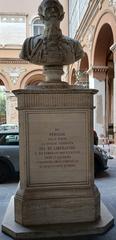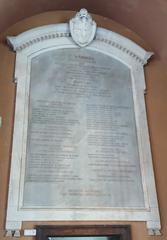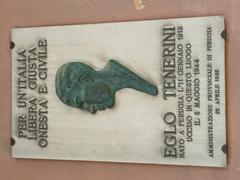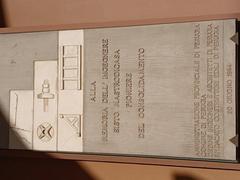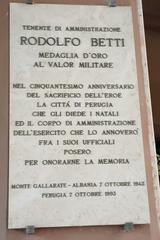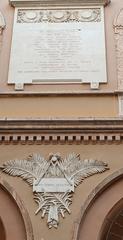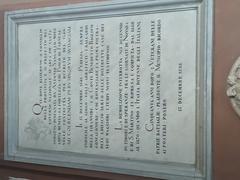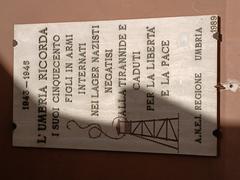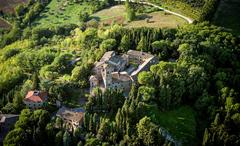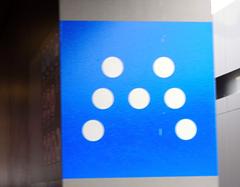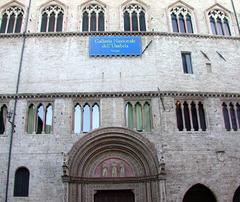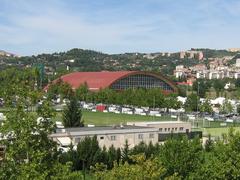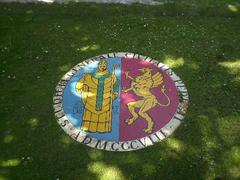
Palazzo della Provincia e della Prefettura Perugia: Visiting Hours, Tickets, and Travel Guide
Date: 14/06/2025
Introduction
The Palazzo della Provincia e della Prefettura in Perugia is a monumental testament to the city’s transformation from papal stronghold to a modern center of civic administration. Built atop the ruins of the Rocca Paolina between 1867 and 1873, the palace not only reflects Italy’s unification but also serves as a vibrant hub of artistic, cultural, and governmental activity in Umbria (Provincia di Perugia). Its distinctive neo-Renaissance architecture—marked by alternating bands of white and pink stone, elegant arcades, and intricate decorative elements—houses a trove of frescoes and murals by celebrated Umbrian artists. Today, the palazzo remains the seat of the province and the prefecture, welcoming visitors through guided tours and public events that illuminate Perugia’s rich civic and artistic legacy (Comune di Perugia; Wikipedia).
Table of Contents
- History and Architectural Development
- Civic and Artistic Functions
- Visiting Hours, Tickets, and Tours
- Accessibility and Visitor Facilities
- Key Attractions and Itineraries
- Conservation and Restoration
- FAQs
- Visuals and Media
- Conclusion & Travel Tips
- Sources
History and Architectural Development
From Rocca Paolina to Civic Symbol
The palace stands on the site of the demolished Rocca Paolina, once a symbol of papal dominance. Its construction, following Umbria’s annexation to the Kingdom of Italy, was both a practical and symbolic act—marking the region’s shift from ecclesiastical to secular governance (Provincia di Perugia). Architect Alessandro Arienti’s design drew from Lombard, Venetian, and Bolognese influences, intentionally setting the building apart from local architectural traditions and signifying a new civic identity.
Architectural Highlights
- Façade: Alternating white and pink stone bands, harmonious with Perugia’s historic cityscape.
- Entrance: Central portal flanked by Corinthian pilasters and crowned with the provincial coat of arms.
- Interior: Grand marble staircase, the octagonal Sala del Consiglio Provinciale with stained-glass skylight, and lavishly frescoed ceremonial halls (Comune di Perugia).
Civic and Artistic Functions
Administrative Heart of Umbria
Since its inauguration in 1873, the palazzo has been the headquarters of both the provincial government and the Prefecture, playing a central role in regional governance, public order, and civic life (Regione Umbria). The design incorporates both working offices and spaces for public engagement, such as the Sala dei Ricevimenti and the Hall of Coats of Arms.
Artistic Heritage
- Frescoes and Murals: Created by renowned artists including Domenico Bruschi, Mariano Piervittori, Matteo Tassi, and others, the interiors depict allegories of justice, unity, and Perugia’s storied history (Wikipedia).
- Notable Rooms: The Sala del Consiglio Provinciale features a coffered ceiling and stained-glass skylight; the Sala degli Stemmi displays the coats of arms of Umbrian cities.
Visiting Hours, Tickets, and Tours
Standard Opening Hours
- By Reservation Only: As of June 2025, visits are available Monday to Friday, 10:30–11:30, and Monday to Thursday, 15:30–16:30.
- How to Book: Reservations must be made by calling +39 800 134 74 (Provincia di Perugia).
- Admission: Ticket prices may vary depending on exhibitions or guided tours; confirm details when booking. General admission is often free, but special exhibitions may require a ticket.
Guided Tours and Access
Guided tours offer access to areas typically closed to the public, such as:
- Grand reception halls with 19th-century frescoes by Bruschi
- The Sala degli Stemmi, with heraldic art by Tassi
- Southern gallery decorated by Piervittori
- The meeting room of the provincial deputation featuring works by Panti and Cherubini (Wikipedia IT)
Accessibility and Visitor Facilities
- Mobility: The palazzo is partially accessible; main entrances and some areas are wheelchair-friendly, but certain historic upper floors may have limited access. Notify staff of special needs when booking (Provincia di Perugia).
- Facilities: Restrooms are available. Numerous cafés and restaurants in Piazza Italia offer refreshment.
- Photography: Allowed in most areas, but check specific room guidelines during the tour.
Key Attractions and Suggested Itineraries
Location and Getting There
Located in Piazza Italia, the palazzo is a short walk from Perugia’s main train station via bus or minimetro (Trek Zone; Rossi Writes). The area is pedestrian-friendly, though the city’s medieval layout means some streets are steep and cobbled.
Nearby Highlights
- Palazzo dei Priori: Gothic masterpiece and National Gallery of Umbria (6 min walk)
- Fontana Maggiore: Iconic 13th-century fountain (7 min walk)
- Pozzo Etrusco: Ancient Etruscan well (8 min walk)
- Perugia Cathedral: Main city church (8 min walk)
- Palazzo Donini: 18th-century noble palace, seat of the Regional Council (2 min walk)
CERP – Centro Espositivo Rocca Paolina
Beneath the palace, the CERP exhibition center hosts art shows and cultural events. Access via the western portico and escalators (Wikipedia IT).
Conservation and Restoration
The palace underwent major restoration after the 1997 Umbria earthquakes, ensuring continued preservation of its architectural and artistic features (Sisma Umbria; Ministero della Cultura). Ongoing care is managed by regional heritage authorities.
Frequently Asked Questions (FAQ)
Q: What are the visiting hours?
A: Visits are by reservation only, Monday to Friday 10:30–11:30 and Monday to Thursday 15:30–16:30 as of June 2025.
Q: How do I book tickets?
A: Call +39 800 134 74 to reserve your visit (Provincia di Perugia).
Q: Are there entrance fees?
A: General visits are often free; special exhibitions may have ticket fees.
Q: Is the building accessible for visitors with disabilities?
A: Partial accessibility is available; confirm specific needs when booking.
Q: Are guided tours available in English?
A: English-speaking guides may be available on request; specify when booking.
Q: Can I photograph inside?
A: Frequently permitted, but always check with your guide for any restrictions.
Visuals and Media
Explore images of the façade, grand staircase, and frescoed halls on the Comune di Perugia tourism site.
Virtual tours and interactive maps are often available to enhance your planning.
Conclusion & Travel Tips
The Palazzo della Provincia e della Prefettura is an essential stop for anyone interested in Perugia’s history, art, and civic life. Its blend of 19th-century architecture, artistic treasures, and ongoing administrative function makes it unique among Italian landmarks.
- Book in advance, especially during festivals.
- Wear comfortable shoes; expect walking on cobblestones and stairs.
- Combine your visit with nearby historical gems for a full Perugia experience.
- Check official websites for latest hours and event updates.
- Download the Audiala app for guided audio tours and follow us on social media for event updates.

